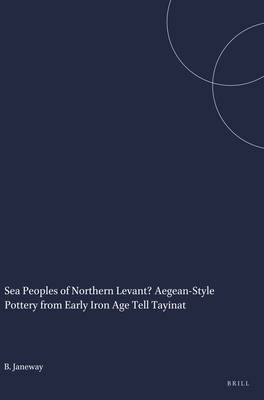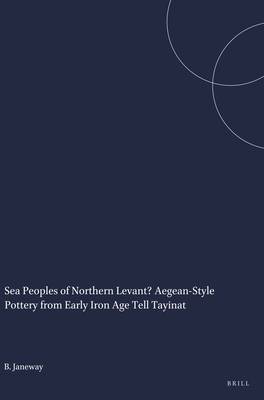
- Afhalen na 1 uur in een winkel met voorraad
- Gratis thuislevering in België vanaf € 30
- Ruim aanbod met 7 miljoen producten
- Afhalen na 1 uur in een winkel met voorraad
- Gratis thuislevering in België vanaf € 30
- Ruim aanbod met 7 miljoen producten
Zoeken
Sea Peoples of Northern Levant? Aegean-Style Pottery from Early Iron Age Tell Tayinat
Brian Janeway
€ 100,95
+ 201 punten
Omschrijving
Did an invasion of the Sea Peoples cause the collapse of the Late Bronze Age palace-based economies of the Levant, as well as of the Hittite Empire? Renewed excavations at Tell Tayinat in southeast Turkey are shedding new light on the critical transitional phase of the Late Bronze/Early Iron Age (ca. 1200-1000 B.C.), a period that in the Northern Levant has until recently been considered a "Dark Age," due in large part to the few extant textual sources relating to its history. However, recently discovered epigraphic data from both the site and the surrounding region suggest the formation of an Early Iron Age kingdom that fused Hieroglyphic Luwian monumental script with a strong component of Aegeanizing cultural elements. The capital of this putative/erstwhile kingdom appears to have been located at Tell Tayinat in the Amuq Valley.
More specifically, this formal stylistic analysis examines a distinctive painted pottery known as Late Helladic IIIC found at the site of Tayinat during several seasons of excavation. The assemblage includes examples of Aegean-style bowls, kraters, and amphorae bearing an array of distinctive decorative features. A key objective of the study distinguishes Aegean stylistic characteristics both in form and in painted motifs from those inspired by the indigenous culture.
Drawing on a wide range of parallels from Philistia through the Levant, Anatolia, the Aegean Sea, the Greek Mainland, and Cyprus, this research begins to fill a longstanding lacuna in the Amuq Valley and attempts to correlate with major historical and cultural trends in the Northern Levant and beyond.
"In Sea Peoples of the Northern Levant, Janeway ably navigates the complex context within which these data must be historically and archaeologically situated and provides a first look at the Aegeanizing ceramics from the Tell Tayinat assemblage that is both comprehensive and invaluable.... For researchers and scholars working within the complex material and historical tapestry of the Late Bronze-Early Iron Age transition in the eastern Mediterranean, this volume is highly recommended." - Jeffrey P. Emanuel, Harvard University, in: American Journal of Archaeology 123.3 (2019)
More specifically, this formal stylistic analysis examines a distinctive painted pottery known as Late Helladic IIIC found at the site of Tayinat during several seasons of excavation. The assemblage includes examples of Aegean-style bowls, kraters, and amphorae bearing an array of distinctive decorative features. A key objective of the study distinguishes Aegean stylistic characteristics both in form and in painted motifs from those inspired by the indigenous culture.
Drawing on a wide range of parallels from Philistia through the Levant, Anatolia, the Aegean Sea, the Greek Mainland, and Cyprus, this research begins to fill a longstanding lacuna in the Amuq Valley and attempts to correlate with major historical and cultural trends in the Northern Levant and beyond.
"In Sea Peoples of the Northern Levant, Janeway ably navigates the complex context within which these data must be historically and archaeologically situated and provides a first look at the Aegeanizing ceramics from the Tell Tayinat assemblage that is both comprehensive and invaluable.... For researchers and scholars working within the complex material and historical tapestry of the Late Bronze-Early Iron Age transition in the eastern Mediterranean, this volume is highly recommended." - Jeffrey P. Emanuel, Harvard University, in: American Journal of Archaeology 123.3 (2019)
Specificaties
Betrokkenen
- Auteur(s):
- Uitgeverij:
Inhoud
- Aantal bladzijden:
- 224
- Taal:
- Engels
- Reeks:
- Reeksnummer:
- nr. 7
Eigenschappen
- Productcode (EAN):
- 9781575069500
- Verschijningsdatum:
- 1/01/2017
- Uitvoering:
- Paperback
- Formaat:
- Trade paperback (VS)
- Afmetingen:
- 165 mm x 239 mm
- Gewicht:
- 199 g

Alleen bij Standaard Boekhandel
+ 201 punten op je klantenkaart van Standaard Boekhandel
Beoordelingen
We publiceren alleen reviews die voldoen aan de voorwaarden voor reviews. Bekijk onze voorwaarden voor reviews.











